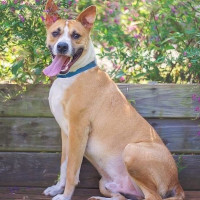Appearance of the Great Dasenji
|
| Like a Basenji, this elegant hybrid has a tapered muzzle with a scissor bite, dark almond-shaped eyes and erect, slightly hooded ears. Like a Great Dane, however, this breed has round, compact feet with highly arched toes. Great Dasenjis have a short, fine, smooth coat that comes in solid or multicolored combinations of blue, fawn, black, white, beige and red with a harlequin pattern, merle coat or brindle, with brindle, black or white markings. They are agile, graceful animals with an alert, inquisitive expression. |
Temperament of the Great Dasenji
|
| The Great Dasenji can be fierce, but make no mistake. This dog is gentle, affectionate and curious. They're not as needy as Great Danes, but they do expect a lot of attention. Great Dasenjis will seek out hugs and kisses from their owners whenever possible. However, Great Dasenjis may not warm up to other adults, children or pets without a little time and encouragement. As such, it's best for Great Dasenji owners to supervise their pets with strangers. Nevertheless, Great Dasenjis are playful and will enthusiastically engage in games and activities if they're comfortable. Because this breed is so intelligent, it will become restless if it doesn't receive sufficient mental and emotional stimulation. This breed also inherits some of the Basenji's stubbornness. As a result, it may not be as easy to train as other Great Dane hybrids. Still, many dog fans appreciate the Great Dasenji's sequence of independence and sense of mischief. |
Needs and activities of the Great Dasenji
|
| Depending on Great Dasenji's temperament, he may enjoy vigorous fun in the park with other furry friends. Otherwise, they'll be content to take long walks with their owner. This breed is suitable for all types of environment, although it should never be over-exercised in extremely hot or cold conditions. What's more, because of this breed's activity requirements, it can do best in a suburban or rural environment where it has access to large outdoor spaces. Note that Great Dasenjis have a strong urge to hunt and chase small animals, so it's best to keep this dog in a fenced area. |
Maintenance of the Great Dasenji
|
| Great Dasenjis are ideal for owners who aren't interested in a high-maintenance dog. This breed requires no brushing, has a short, neat coat and sheds only moderately throughout the year. What's more, Great Dasenjis only need to be bathed once a month. They should, however, have their teeth cleaned daily. Beyond that, Great Dasenjis should have their nails trimmed at least twice a month and their ears checked regularly for wax build-up and excess moisture, which can at least be detrimental to yeast proliferation. In addition, this dog is quite slobbery, so its mouth and muzzle need to be wiped regularly. Please note that Great Dasenjis are not hypoallergenic and therefore not suitable for owners of allergic dogs. |









 English (United Kingdom)
English (United Kingdom)